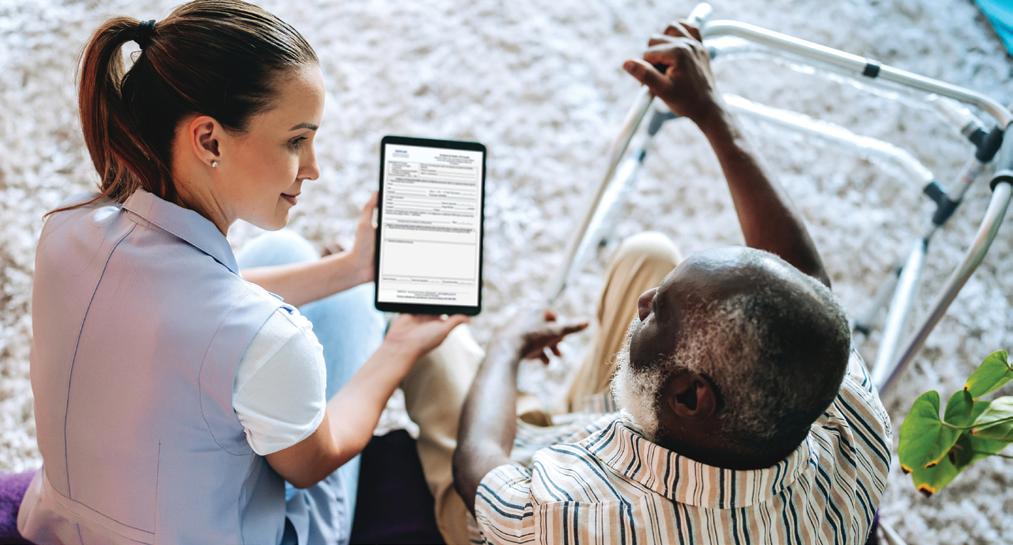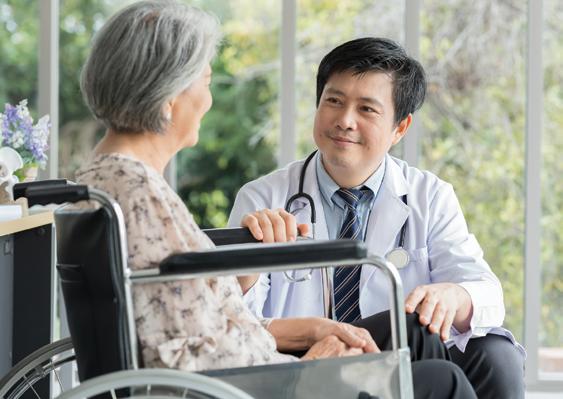With Older Adults Communicating
A Review of What Really Works
Ageism in Health Care Advisory Board
Marilyn R. Gugliucci, MA, PhD, FAGHE, FGSA, FAGS, FNAOME
Advisory Board Chairperson
Division of Geriatrics
University of New England College of Osteopathic Medicine
Terri Harvath, PhD, RN, FAAN, FGSA
School of Nursing
University of Minnesota
Mark Brennan-Ing, PhD, FGSA
Brookdale Center for Healthy Aging Hunter College, City University of New York
Becca Levy, PhD, FGSA
Yale School of Public Health
Yale University
Spero M. Manson, PhD University of Colorado Denver Department of Community & Behavioral Health
University of Colorado Anschutz Medical Campus
Joann M. Montepare, PhD, FGSA, FAGHE, FAPA
Professor Emerita of Psychology
Lasell University
Andrew Steward, PhD, LCSW
Helen Bader School of Social Welfare
University of Wisconsin-Milwaukee
Mary Tinetti, MD, FGSA
Yale University School of Medicine
Yale University
GSA Staff
James Appleby, BSPharm, MPH, ScD (Hon)
Lisa C. McGuire, PhD, FGSA
Elana Kieffer, MBA
Ophira Bansal, MBA
AARP Staff
Karen Chong
Stacie Sampson
Melisa Ford
Developed by
Support provided by
Introduction
Effective communication with patients of all ages is essential for ensuring understanding and ultimately providing quality care. Good communication helps to establish rapport and build a trusting therapeutic relationship, which (Stivers):
• Increases the likelihood of obtaining accurate and thorough information from the patient to support diagnosis and management of a wide range of conditions.
• Is helpful for supporting understanding of and adherence to treatment recommendations.
• Improves patient satisfaction with treatment and sense of care.
People of all ages may have conditions that impede communication and health care providers may need to adapt their communication strategies to address individualized patient needs. While it is important to avoid stereotypes about older adults, health care providers should also recognize that many conditions that can impede communication are more likely to impact people as they age. In fact, roughly one third of all adults 65 years of age and older report having some type of disability. (ACL)
As the population ages, health care providers across a wide range of practice settings are increasingly likely to interact with older adults on a regular basis. In 2020, adults 65 years of age and older comprised approximately 17% of the
population of the United States, or nearly one out of every six people, and this proportion of the population is growing. (Census)
More than 90% of adults aged 65 years and older had at least one doctor visit in 2023, and the majority have at least one chronic health condition that requires ongoing management. (NCHS) Read on to learn more about strategies that can support communication with all patients and strategies that are particularly helpful for adults with specific communication challenges.
Communication Challenges
There are many barriers to communication—including low health literacy, vision impairment, hearing difficulty, and cognitive conditions—that can necessitate an individualized approach.
Health Literacy
Health literacy is a more complex skill than general literacy. It impacts how well an individual is able to interact with the health care system and adhere to recommended self- care strategies. Health literacy involves being able to access, understand, appraise, and use health care information and services in ways that promote and maintain good health and well-being. (WHO) People with basic or below basic health literacy may have difficulty with tasks such as synchronizing tasks or locating numbers and using them to solve one-step calculations. People with basic or below basic health literacy may have difficulty understanding and following a complex care plan that involves multiple appointments, medications taken at specific times, or dietary restrictions. (WHO)
• They aren’t familiar with medical terms or concepts of anatomy and physiology.
• They have to interpret and apply statistics to evaluate risks and benefits for their own health.
• They are diagnosed with a serious illness or have to make an important decision and are scared, stressed, or confused.
Health literacy is a social determinant of health and low health literacy is associated with a greater negative impact on health outcomes than income, employment status, educational level, or racial/ethnic group. (WHO)
Older adults are more likely than younger adults to have low health literacy. Because it is impractical to determine someone’s health literacy levels during regular interactions, health care providers should aim to provide easy-to-understand information to all their patients. (Weiss) Use simple, straightforward language and avoid using medical jargon to help support comprehension.
Vision and Hearing Conditions
Sensory impairments that can impede communications include both visual and auditory deficits. Visual impairments may impact written communication. They can occur at any age and become more common as people get older. As people age, they may have increasing difficulty seeing things up close, distinguishing colors, and adjusting to changing levels of light. Large print materials and well-lit spaces can be helpful for people with many types of visual impairments.
Hearing loss, including deafness and age-related hearing loss (ARHL), can hinder verbal communication. ARHL can impact people at any age but increases in prevalence as people age. Clinically significant hearing loss affects over two-thirds of adults 60 years of age and older. (Lin) Signs of ARHL include: (NIA)
• Having difficulty understanding people over the telephone.
• Having difficulty following conversations when two or more people are talking.
• Often asking people to repeat what they said.
• Needing to turn up the volume on electronic devices.
• Thinking others are mumbling.
• Having difficulty understanding high-pitched voices.
Some people may not want to admit they are having difficulty hearing, and it may be difficult to immediately determine whether someone is experiencing hearing loss.
To make it easier for people with hearing loss, speak at a moderate pace and enunciate clearly; speak louder if necessary but avoid shouting. Facing the person directly when speaking will help with lip-reading. ARHL is associated with several risks (e.g., increased risk for dementia) and potential cognitive benefits from treating hearing loss. Untreated ARHL significantly increases the risk of social isolation, depression, falls, and cognitive decline (including dementia). It can also negatively impact communication, job performance, and overall quality of life. (Lin) If it appears appropriate, consider making a referral for further evaluation.
Cognitive Conditions
Cognitive impairment increases in prevalence as people age, is highly variable from one person to another, and typically progresses over time. Symptoms can range from mild cognitive impairment to severe dementia. As cognitive impairment emerges, providers may notice vague signs of memory loss and confusion that worsen gradually over the course of many visits. As impairments advance, providers may notice that patients show signs such as disorganized thinking, impaired judgment, trouble expressing themselves, difficulty recognizing familiar people, and disorientation to time, space, and location. All these signs of cognitive impairment may need providers to adjust how they communicate with affected older adults and may warrant involvement of caregivers in managing their needs.
Establish a Respectful and Comfortable Environment
There are several steps that health care providers can take to help their patients feel comfortable and respected during interactions to support effective communication. Health care settings that are quiet, well-lit, and free of distractions can help patients feel comfortable in the setting and can make it easier for them to hear oral messages and read written information. If patients have hearing deficits, carefully enunciating words while using a slightly raised voice may be helpful, but avoid yelling or using a tone of voice that sounds frustrated or patronizing. There is no need to speak slower or faster than your normal speech rate. The goal is to be clear in your enunciation of words while maintaining the intended intonation of your sentence.

Attention to the physical space and how it will impact people with various needs is also important—hallways and doorways should be wide enough for a wheelchair. Additionally, seating should be comfortable and able to accommodate people who are a larger size.
To help put people at ease, greet them warmly using their preferred name,and talk with them respectfully, treating them as equals. Face people directly when speaking and try to put yourself at eye level with patients rather than standing over them when they are seated. Particularly if the patient is in a wheelchair, it is valuable to seat yourself at the same level to create a sense of connection.
With the patient’s consent, include caregivers in discussions to support and reinforce communication. If a caregiver is attending the visit with the patient, ensure that communications are directed primarily to the patient to the extent possible. Avoid talking with the caregiver as though the patient were not in the room.
Be Mindful of Nonverbal Communication
Although words are influential, tone of voice and body language—including facial expressions and body posture— contribute significantly to how a message is conveyed and received. These nonverbal cues are an essential element of communication and can be used to build trust, demonstrate empathy, and help people feel comfortable and respected. Alternatively, off-putting nonverbal communication can undermine these goals. Health care providers should note their patients’ nonverbal communication during interactions to assess how the patients are feeling about the interaction and be mindful of their own.
Tips for managing your nonverbal communication
• Keep arms uncrossed to appear open and approachable.
• Face people and lean slightly forward to convey interest and attentiveness.
• When possible, sit at eye level with the patient to foster a sense of equality and respect.
• Use gentle, direct eye contact, but avoid staring.
• Smile when appropriate to ease patient anxiety and build rapport.
• Avoid frowning or appearing rushed, because patients may perceive it as impatience or frustration.
• Nod occasionally and use affirmations (such as “mm-hmm” or “I see”) to show understanding and encourage the patient to continue.
• Be sensitive to cultural differences that have varying norms for eye contact, touch, and personal space and adjust as needed if the patient seems uncomfortable.
• Subtly match a patient’s body language to create a sense of connection.
By being mindful of these nonverbal cues, health care providers can foster better communication, enhance patient trust, and improve overall care experiences.
If you are using a computer to access and document information in an electronic health record, be sure to look away from the computer screen and make eye contact with the patient to the extent possible.
Use Active Listening Techniques
Active listening is a communication approach to acquire needed information by encouraging speakers to share more openly and helping them feel heard and valued. It can involve several strategies, including:
• Demonstrating attentiveness with nonverbal communication, including maintaining eye contact, facing the person speaking, and avoiding distractions.
• Being patient as people share information by avoiding interrupting them and finishing their sentences as well as by allowing pauses for speakers to offer additional information.
• Asking follow-up questions.
• Repeating or rephrasing important information to ensure understanding. “So you’re saying the pain is worse at night?”
• Validating concerns and acknowledging feelings. “It sounds as though that was very frustrating.”
• Summarizing and clarifying what was said. “You’re experiencing a lot of pain, which is stopping you from exercising. Did I get that right? Am I missing anything?”
Use Open-Ended Questions
Open-ended questions that encourage deeper conversation are essential for gathering information from patients and can provide much more detail and context than closed questions. Open-ended questions allow patients the opportunity to more freely express themselves and their health-related needs. Closed questions are appropriate in some situations such as when a provider wants to confirm specific information—for example, “Is Dr. Smith your neurologist?”
Consider how patients might respond differently to these questions:
Open-Ended Questions
Closed Questions
What do you hope to get out of your You are here for your 3-month visit today? check-up, correct?
How have you been doing since our Is everything going okay? last visit?
How do you use this medication? Have you been taking this medication as prescribed?
What other symptoms are you having? Are you having any other symptoms? What questions or concerns do you Do you have any questions? have? What would you like to know more about?
Can you tell me more about that? Anything else?
Provide Written or Visual Information
Using written and visual materials both to explain information during visits and for patients to take home for later reference helps to reinforce messages that are communicated verbally. These materials can also help clarify and reinforce comprehension of key points during conversations. Providing people with the opportunity to write down questions and answers during visits can help improve communication. Written summaries of visits are also important for communicating information to caregivers and other members of the care team.
By simply pointing to a graphic, both speakers and listeners can accurately and easily refer to visually shared information. Shared visual aids also help conversational participants coordinate their attention on key information. Visual aids are better able to illustrate complicated relationships among concepts compared with using words alone.
Written and other visual materials can be helpful for those with hearing loss or cognitive impairment. They should be designed with various potential needs in mind, including low health literacy and visual decline. Larger print and simple graphics can help with readability for both comprehension and visual appeal. Providing information digitally can also be helpful for some people because they may be able to use tools such as screen readers to have digital information read aloud.
Use the Teach-Back Method
The teach-back method is an effective approach to use with patients (and their caregivers where appropriate) for assessing and supporting understanding and retention of information. It enhances patient confidence and adherence to treatment plans and can promote shared decision-making and patient-centered care.
This method involves asking patients to restate the information from the provider in their own words. The provider notes whether the information the patient recalls is accurate and determines whether there are any gaps to address. The provider clarifies and reteaches information as needed until the patient can accurately explain it.
Teach-Back Method Steps
1. 2. 3. 5. 4.
Explain the Information Clearly. Use simple, plain language instead of medical jargon.
Ask the Patient (or Caregiver) to Repeat the Information in Their Own Words. Phrases that can be used include:
• “To make sure I explained that well, can you tell me how you’ll take this medication at home?”
• “I want to be sure we are on the same page. Can you tell me…?”
• “I want to make sure that I explained things clearly. Can you repeat back to me what we just talked about?”
Assess Understanding. If patients repeat the information correctly, reinforce their understanding with supportive phrases.
Clarify and Reteach if Needed. If patients say something that is not completely correct, respectfully and calmly present the information again, rephrasing it if needed. Then ask them to tell it back to you in their own words again.
Repeat Until the Patient Understands. Continue the cycle until the patient can confidently explain the information. If the patient cannot understand the information due to cognitive issues, consider other supports that may be required.
Source: OMH
Apply the LEARN Model
In some cases, patients may disagree with the information provided for various personal or cultural reasons. Providers should customize care by seeking information about patients’ personal and cultural beliefs and values about their health care choices.
The LEARN model provides a framework for listening, explaining, acknowledging, recommending, and negotiating health information and instructions when perceptions about health issues differ. In this model, providers: (OMH)
L isten with empathy to the patient’s perception of the problem.
E xplain their own perception of the issue.
A cknowledge and discuss differences and similarities.
R ecommend treatment.
N egotiate agreement.
Patients should be acknowledged as the experts about their individual experiences (“You know your own body better than I do”) and the provider should work with each patient to arrive at a mutually agreeable treatment plan. Ultimately, the provider should aim for a treatment plan that is developed with the patient’s involvement, including culturally appropriate aspects.
Adapt Communication as Needed for People With Cognitive or Memory Issues
People with cognitive or memory issues present with a wide range of impairments that may progress over time. To meet these evolving needs, providers should r egularly assess changes in cognitive function and adapt communication approaches to the patient’s degree of understanding. In some cases, this may involve repeating information and reinforcing it with visual aids, written materials, and strategies such as the teach-back method. However, if dementia is identified or emerges, support from caregivers may be needed to effectively gather and share information.
Older adults with dementia retain their ability to process the tone of communication. A calm and reassuring tone can facilitate responsive behaviors in people with cognitive decline and reduce the likelihood of behaviors such as agitation.
When gathering information, it may become necessary to pose questions that offer brief options rather than using open-ended questions. If you need to solicit additional information from caregivers, maintain eye contact with patients and avoid referring to them in the third
person. For example, when asking a caregiver about side effects, look at the patient and ask, “Are you experiencing side effects?” and wait for the caregiver to respond rather than looking at the caregiver and asking, “Did she complain about side effects?”
When sharing information, a helpful approach is to provide manageable chunks of information to patients. Give one instruction at a time and use visual aids when possible.
Regardless of patients’ level of function, it is important to include them in conversations and decision-making to the extent possible when a caregiver accompanies them to appointments. Family members or primary caregivers may begin to “speak for” the older adult for example, by reporting problems and symptoms or offering their assessment of responses to various treatments. The family members or caregivers also may begin to assume a shared role with the physician regarding the diagnosis and evaluation. To keep the patient involved, use inclusive terms such as “we” or “you” to maintain a sense of joint voices. Have the older adult verify information provided by the family member or caregiver to help establish the patient’s autonomy and responsibility for personal health.
Summary
Respectful, clear, and empathetic communication that fosters trust, improves health outcomes, and supports autonomy is important when interacting with older adults in healthcare settings to support quality of care.
As people age, they may experience sensory, cognitive, and physical changes that can affect how they receive and process information. Providers can adapt their communication approaches to address these challenges. Strategies can include speaking clearly and using plain language, avoiding medical jargon, and providing information both verbally and in written or visual form—preferably with large print and simple graphics.
Active listening, allowing extra time for responses, and involving caregivers (while keeping the patient at the center of the conversation) are also crucial strategies. Principles of cultural sensitivity and person-centered communication should be incorporated and adapted to each individual’s needs.
References
(ACL) Administration for Community Living. 2019 Profile of Older Americans. May 2020. https://acl.gov/ sites/default/files/Aging%20and%20Disability%20in%20America/2019ProfileOlderAmericans508.pdf
(Census) Caplan Z. US older population grew from 2010 to 2020 at fastest rate since 1880 to 1890. May 25, 2023. https://www.census.gov/library/stories/2023/05/2020-census-united-states-older-population-grew.html
(Lin) FR. Age-related hearing loss. N Engl J Med. 2024;390(16):1505–1512. doi:10.1056/NEJMcp2306778
(NCHS) National Center for Health Statistics. Percentage of having a doctor visit for any reason in the past 12 months for adults aged 18 and over, United States, 2019–2023. National Health Interview Survey. Generated interactively February 24, 2025. https://wwwn.cdc.gov/NHISDataQueryTool/SHS_adult/index.html
(NIA) National Institute on Aging. Hearing Loss: A Common Problem for Older Adults. January 19, 2023. https://www.nia.nih.gov/health/hearing-and-hearing-loss/hearing-loss-common-problem-older-adults
(OMH) U.S. Department of Health and Human Services, Office of Minority Health. Providing CLAS. Accessed March 11, 2025. https://thinkculturalhealth.hhs.gov/assets/pdfs/resource-library/providing-clas.pdf
(Stivers) T, Tate A. The role of health care communication in treatment outcomes. Annu Rev Linguist. 2023;9:233–252.
doi:10.1146/annurev-linguistics-030521-054400
(Weiss) BD. Health Literacy and Patient Safety: Help Patients Understand. Manual for Clinicians. 2nd edition. American Medical Association Foundation; 2007. http://www.hhvna.com/files/Courses/HealthLiteracy/ Health_Literacy_Manual_AMA_Revisd.pdf
(WHO) World Health Organization. Health literacy. August 5, 2024. https://www.who.int/news-room/fact-sheets/detail/health-literacy


















